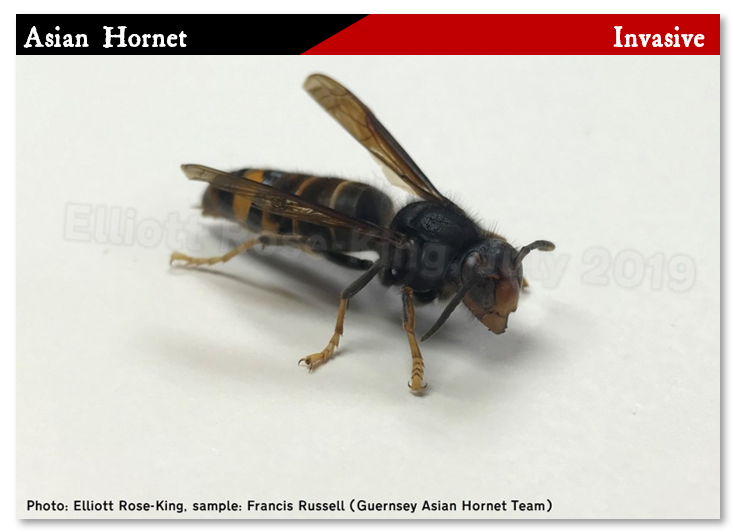Asian Hornet (Invasive Species)
Vespa velutina (commonly known as the Asian hornet, or Yellow-legged hornet) is an invasive species that first arrived in Europe in 2004 and is a risk to people and our native insects (especially honeybees and other important pollinators).
A sighting has been officially confirmed in Ashford as of the 9th of September 2019 (according to GOV.uk) following a few earlier sightings in the south (including Dungeness) the same year, so it is important to be aware of how to identify an Asian hornet and where to report it if you do see one.
Unlike our native European hornets (Vespa crabro), they are slightly smaller in length (between 20 mm and 32 mm, compared to 25 mm – 35 mm for our native hornets). They also have distinctive yellow-tipped legs and a mainly black body, with an orange band on the 4th section of the abdomen.
They present a serious risk to our native wildlife as, unlike our native hornets, they will predate honeybees for protein. Depending on if they are in a rural or urban environment, honeybees can account for between 34% and 66% of their protein diet!
Away from the nest an Asian hornet should not be more of a threat to people than our native wasps. However, if a person approaches the area around their nest, they may also become defensive. The sting of an Asian hornet also contains an ‘alarm pheromone’, so if you are stung, other hornets from the nest may follow the pheromone and also try to sting you. Their stings can be up to 6 mm long too, so they will penetrate most normal protective suits. Due to this an Asian hornet nest should only be approached by a competent professional that is aware of the risks.
(information sourced from links below and GOV.uk)
The Non-Native Species Secretariat (NNSS) have produced a good ID and information guide on the Asian hornet here:
Another good ID and information sheet has been produced by the French Natural History Museum and is available here, like the previous PDF it also includes information about species often misidentified as an Asian hornet, but this one also includes information about Asian hornet nesting locations found in Europe so far (although it is important to remember that this is still emerging research and nests have been found in a variety of different locations!):
If you see an Asian hornet and need to report it, you can download the ‘Asian Hornet Watch’ app for iPhone and Android here, the app also includes ID guides and other useful features:
iPhone: https://apps.apple.com/gb/app/asian-hornet-watch/id1161238813
Android: https://play.google.com/store/apps/details?id=uk.ac.ceh.hornets&hl=en_GB










